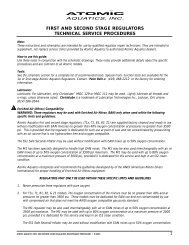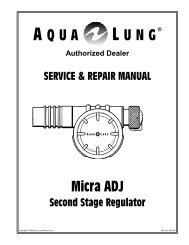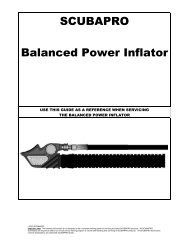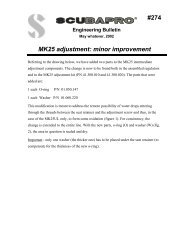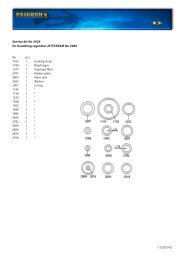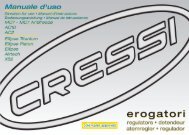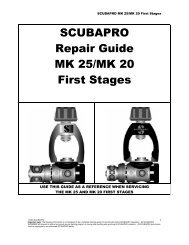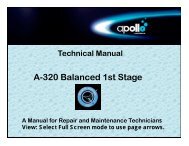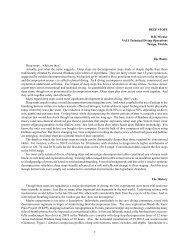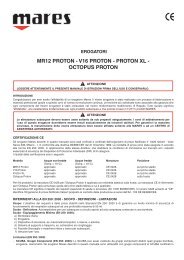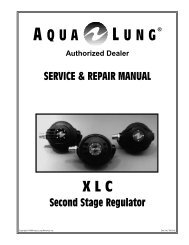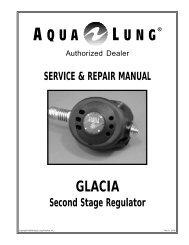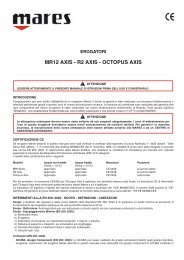limitazioni riferimenti alla en1809-scopo-def - Frogkick.dk
limitazioni riferimenti alla en1809-scopo-def - Frogkick.dk
limitazioni riferimenti alla en1809-scopo-def - Frogkick.dk
Create successful ePaper yourself
Turn your PDF publications into a flip-book with our unique Google optimized e-Paper software.
Scuba - Minimum equipment (EN 250):a) Air cylinder / cylindersb) Demand regulatorc) Safety device, e.g. pressure gauge / computer or reserve oralarm.d) Carrying frame or holding device for air cylinder(s) to mountthe harness, or carrying system, e.g. backpack and/or straps,B/C harness.e) Facepiece: mouthpiece assembly or full face mask or divinghelmet.f) Operating instructions.Limits (EN 250) - Maximum depth: 50 m / 162 feet.SCUBA - Component units (EN 250): The SCUBA equipmentmay consist of separate component units such as cylinders,regulator and pressure gauge. The Mares HUB described in thismanual may be used with any SCUBA components certified incompliance with EC directive 89/686. The air contained in thecylinders must comply with the requirements for breathable air setforth in EN 132 - Appendix A.REFERENCES TO EN 1809 - OBJECTIVE -DEFINITIONS - LIMITATIONSObject: The EN 1809 directive examines the minimum safetyrequirements and the performance of inflatable buoyancycompensator vestsBuoyancy Compensator Vest - Definition (EN 1809): A deviceallowing the diver to control his/her buoyancy during the dive.The HUB described in this manual has been tested and certifiedfor temperatures between -20°C and + 60°C.The following warning label is stitched on the BC: WARNINGThe object of the EN 1809 Standard does not cover therequirements for floating devices or safety jackets. Abuoyancy compensator vest is not designed or intendedto guarantee, on the surface, a head-up position to anunconscious or a temporarily disabled diver. WARNINGRead this manual carefully. The improper use of anydiving equipment can result in serious injury or death.SCUBA diving equipment should be used by certifieddivers only. Professional training should be obtainedexclusively from a certified instructor with a nationalrecognized training agency. For your protection, yourequipment should be serviced by MARES or a MARESAUTHORIZED SERVICE CENTER.IMPORTANT WARNINGSCarefully read the instructions contained in this manual.The HUB is not a life vest: it is not designed to hold thediver's head out of the water. If this instruction bookletis lost, a replacement copy can be obtained from yourMares dealer. Before using the equipment, check forany leaks and make sure that all its components are ingood working order.Consult an Authorized MARES Service center forconnecting or replacing the hoses of your HUB.After use, thoroughly rinse the HUB with fresh water,even if used in a swimming pool.It is also important to rinse the equipment after use in aswimming pool.Improper maintenance may result in damage to theHUB or compromise its correct operation.Do not remove this label for any reason.BC Maximum Lift Table.small N 110 (lbs 24)medium N 130 (lbs 29)large N 150 (lbs 33)extralarge N 170 (lbs 37) WARNINGThe HUB is not just a buoyancy compensator, but anintegrated diving system. As a result, the maximum liftvalues given in the tables are for the complete HUBunit, which includes the first stage, second stage,octopus, manifolds and hoses. Therefore, check yourbuoyancy in the water before starting the dive, becausethe HUB requires less weighting than traditionalsystems.GENERAL REGULATOR WORKING PRINCIPLERegulators reduce cylinder pressure, to a pressure suitable forbreathing. Modern regulators do this in two stages connected by ahose. The first stage provides pressure to the second stage; thisreduced pressure remains constant despite the sizeable changesundergone by the cylinder inlet pressure during the dive (droppingfrom 3000 to few hundred psi). The second stage brings pressuredown to ambient pressure and delivers air only when the diverinhales. Each stage of the regulator contains an internal valve.When the diver inhales, the pressure inside the case is lowered anda pressure differential (imbalance) is created across the diaphragm(beginning of inhalation). The response of the diaphragm is to bendinward, contact the lever and open the second stage valve. Aircontinues to flow into the case until the pressure balance isregained (end of inhalation). WARNINGTHE HUB HAS BEEN CERTIFIED BY THE EC AS ACOMPLETE SCUBA UNIT. THE USE OF ANY OTHERREGULATOR OR OCTOPUS AS PART OF THE HUBVOIDS THE EC CERTIFICATION, EVEN IF THATREGULATOR IS EC CERTIFIED!FIRST STAGEIn order for the second stage to function properly, it must besupplied with air by the first stage at the proper and constantintermediate pressure. This feature of all Mares first stages iscritical for optimum second stage tuning so that the bestperformance can be achieved throughout the dive regardless ofcylinder pressure. The HUB first stages may be connected to thecylinders through a threadedDIN 477/13 adaptor or through an international YOKE CGA 850adaptor, in compliance with EN 250. WARNINGDO NOT attempt to use your regulator unless you haveperformed all of these pre-dive operating procedures.Failure to do so may lead to serious injury or death ifthe regulator malfunctions.SECOND STAGEThe second stage delivers air at ambient pressure only when the diverinhales. When the diver inhales, the pressure inside the second stageis lowered and a pressure differential (imbalance) is created acrossthe diaphragm. The response of the diaphragm is to bend inward,contact the lever and open the second stage valve. Air continues toflow into the second stage case (and to the diver) until the diver stopsinhaling. The pressure then builds up and pushes the diaphragm in theopposite direction, which allows the valve to close and stop delivery.10



